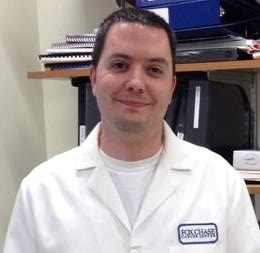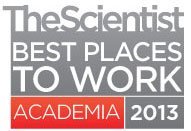
Trainee Spotlight: Ryan Henry, PhD
-
Ryan Henry, PhD

Postdoctoral Fellow
Dr. Andy Andrew’s Lab
Fox Chase Cancer Center
[email protected]Biography
Even when I was little, I had a love for the sciences. By the time I was in high school, I knew that I wanted to pursue a career in scientific research, with a focus on cancer research. With that goal in mind, I majored in Biophysics as an undergraduate at Johns Hopkins University. I was fortunate as an undergraduate to work in the lab of Ru Chich Huang, investigating the effects of a novel cancer therapeutic (M4N) on the proliferation of cancer cells, both in culture and in mice. From there, I went on to study Biochemistry at the University of Rochester School of Medicine and Dentistry. There I worked in the lab of Dr. Robert Bambara, where I studied the mechanisms of DNA lagging strand replication and base excision repair. After grad school, I came to Fox Chase to join the lab of Andy Andrews. I have been working on utilizing mass spectrometry based analysis of histone acetylation to better understand the factors that influence the targeting of lysine acetyltransferases. Currently, I am also working with Alana O’Reilly’s lab to expand our lab’s mass spec based analysis to work within a Drosophila model system. My goal is to continue working in academia, eventually running my own laboratory to study the effects of histone modifications on development and DNA damage repair.
Research Overview
Proper histone acetylation is vital to a number of biological processes. As such, the misregulation of histone acetylation has been implicated in a number of diseases, from cancer, to heart disease, to neurological disorders. Complicating the study of histone acetylation is the fact that many lysine acetyltransferases (KATs) are able to target multiple histone residues, but traditional means of detection often focus on either a single site of acetylation or measure global acetylation levels. Our lab has overcome this obstacle by utilizing a label free, mass spectrometry based method for detection of histone acetylation that allows us to quantitate acetylation of numerous histone residues simultaneously. In order to better understand the mechanisms and factors that regulate histone acetylation, my project began by distinguishing the activities of p300 and CBP, two homologous and prolific KATs. Using our mass spec assay, we were able to determine the kinetics of both KATs, showing that CBP shows a strong preference for H3K18 acetylation, while p300 has a more evenly distributed acetylation pattern across the H3 and H4 tail residues. We were also able to determine that the substrate itself influences KAT activity, with both p300 and CBP displaying different affinities for and acetylation patterns on H3/H4 tetramer, compared to H3 alone.
This study also suggested that the concentration of the co-factor acetyl-CoA plays an important role in regulating the targeting of these enzymes. Therefore, as a follow up, we investigated how C646, a drug the binds to the acetyl-CoA binding pocket of p300 and had been classified as an inhibitor can, under the right circumstances, actually stimulate p300 activity. We found that when C646 is used in low doses, where it can utlimately be outcompeted for p300 binding by acetyl-CoA, it has a stimulatory effect of p300 activity, while high doses are inhibitory, creating a biphasic dependence on the drug. This suggests that binding to the acetyl-CoA binding pocket shifts p300 into a more active confirmation, providing greater insight into the mechanism of p300 activation. Finally, to expand on our work, we have been actively collaborating with a number of members of the Fox Chase community, working with Alfonso Bellacosa’s lab to characterize the interaction between p300 and TDG, with Tim Yen’s lab to generate p300 and CBP knockdown lines and to generate data on the effects of drug treatment on the histone acetylation patterns of cancer cell lines, and with Alana O’Reilly’s lab to integrate our mass spectrometry based detection of histone modification with the powerful genetic tool of a Drosophila model system. Ultimately, by creating a better understanding of the mechanisms that regulate histone acetylation, it is our hope that we will be able to better treat the diseases associated with aberrant histone acetylation.
Featured Publication
Changing the Selectivity of p300 by Acetyl-CoA Modulation of Histone Acetylation
Ryan A. Henry , Yin-Ming Kuo , Vikram Bhattacharjee , Timothy J. Yen , and Andrew J. Andrews *
Department of Cancer Biology, 333 Cottman Avenue, Fox Chase Cancer Center, Philadelphia, Pennsylvania United States
ACS Chem. Biol., 2015, 10 (1), pp 146–156
DOI: 10.1021/cb500726b
Publication Date (Web): October 17, 2014
Copyright © 2014 American Chemical Society
The Scientist Rates Fox Chase a Best Place to Work in Academia

The Scientist rates Fox Chase Cancer Center 7th on the list of Top Ten Best Places to Work Academia 2013.
